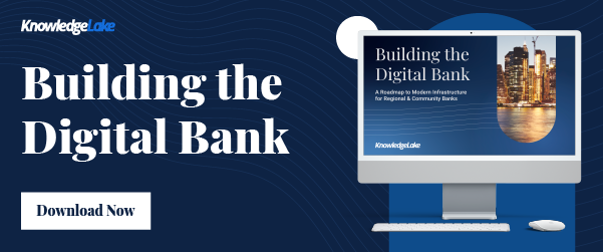Digital Banking Conference 2022: 6 Takeaways from Austin
The KnowledgeLake team attended American Banker’s Digital Banking 2022 conference in Austin last week. It was the first in-person edition of the conference since 2019, and provided an excellent vantage point to take in the major trends and technologies impacting regional banks, community banks, and credit unions.
The speed and scope of change within the entire financial services industry is breathtaking. As more than one speaker noted, we are seeing a once-in-a-lifetime shift that will yield a very different landscape than the one banks and credit unions have known for decades.
We took in the sessions and talked to people on the floor. Here are our most noteworthy takeaways.
Blockchain (not just crypto currency) is a gamechanging technology for all financial institutions.
To be clear, we are not just talking about cryptocurrency, but the underlying technology that makes it work. Blockchain promises greater efficiency while minimizing risk. The opening keynote on the State of Digital Banking highlighted two reasons banks must take Blockchain seriously as a means to eliminate friction in the banking value chain. The first is that Blockchain technology inherently “chains together” the history of an asset, meaning parties are not dependent on subjective representations of the asset. In other words, “you know where all the bodies are buried.” Secondly, banks and other financial institutions can transact or “face off” bilaterally, or directly, without the need for other parties. This disintermediation of the financial ecosystem, to highlight just one example, means that in the payments realm traditional banks could potentially displace merchant acquirers and payment processors, opening up significant new revenue opportunities.
Partnerships between traditional financial institutions and FinTech companies will continue to strengthen.
Banks and credit unions are increasingly forging ongoing relationships with fintech startups and non-traditional financial service providers. This is because each party brings complementary benefits to the other. FinTechs bring innovation and fresh thinking. As Mike Butler of all-digital Grasshopper Bank noted, banks have the charter and the balance sheet. They have experience dealing with and navigating regulation. By extending these significant advantages to FinTech companies, banks gain a new avenue to large-scale deposits. Butler noted that cultural alignment is key to making such partnerships work. Both banks and FinTech companies need to make sure they share the same objectives, have the same philosophy, and are chasing the same type of clients.
There is a massive shift to the cloud.
During the session on “Building a Future-Ready Bank,” Sue Laws, executive vice president of operations for Tenemos, said that banks and credit unions must work toward a platform for the future. These platforms must be extensible so that new technology or “fintech” can be embedded where it is needed. New research presented by American Banker highlighted that cloud-based architecture is the number one investment priority for all banks. Even among banks that consider themselves “trailing” in digital transformation, more than 75 percent still put cloud technology at the top of their roadmap. “Banks of the future are going to be assembled, not built,” said Laws.
Banks and credit unions need to think about (and keep thinking about) the whole stack, not just point solutions.
Moving to the cloud isn’t enough. Banks and credit unions must build a digital infrastructure that can evolve and adapt. Having an extensible architecture is paramount because what’s new today will age faster than previous generations of technology. Lauren Sparks is the founder and CEO of Houston-based Agility Bank, which launched this year. The bank’s goal is creating a digital-first experience for a community bank versus a branch-led experience. She said that “executing the technology right is huge… where we’ll be in five years will be as different as today is from five years ago.” Banks and financial institutions must be able to add, replace and refine processes and offerings in a highly integrated architecture. Investing in stand-alone point solutions without regard for the whole is a recipe for rapid obsolescence.
Digital transformation is about the entire organization, not just a department or a set of initiatives.
The commitment to innovation and doing things differently touches every aspect of banking, starting with leadership and reaching down into the culture. Top to bottom. Financial institutions can’t pigeonhole innovation into a department or stand-alone lab. Innovation leaders from Wells Fargo, Citi Ventures, and Amplify Credit Union said that the biggest issue is mindset. Financial institutions must stop keeping innovation teams separate from the rest of the business. Rather, innovation efforts should align with corporate strategy from the get go. Financial institutions should seek to inject new blood from FinTech startups, and give their employees a permission space to experiment and (yes, at times) fail.
And finally…
The biggest risk of digital transformation is having no digital strategy at all.
In discussion after discussion, the spirit of the conference was clear. The biggest risk for banks and credit unions is having no digital strategy at all. And the gap between leaders and laggards is growing. Sue Laws of Tenemos said that when it comes to digital transformation, the window of opportunity is closing because change is accelerating. Backbase, in their Community Bank session “Avoid Being Yesterday’s Bank,” noted that there were 578 bank mergers and acquisitions between 2019 and 2021. The trailing three years also saw 190 credit unions sold.
“People hear the word ‘digital’ and think risk, but it’s not,” said Lauren Sparks of Agility Bank. She noted that digital means “control over workflows.” When people largely run workflows, taking people out of the equation reduces risk.
For more insights about Digital Banking conference 2022, head to americanbanker.com. And for more about how KnowledgeLake helps banks and credit unions accelerate digital transformation, check out our Resource Center.

